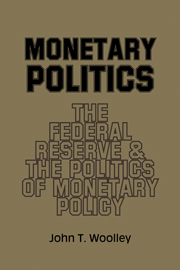Book contents
- Frontmatter
- Contents
- Preface
- 1 The Federal Reserve and the Politics of Monetary Policy: Introduction and Overview
- 2 A Capsule History of the Federal Reserve System
- 3 Recruitment and Selection of Federal Reserve Personnel
- 4 Bankers and the Federal Reserve
- 5 Economists and the Federal Reserve
- 6 The President and the Federal Reserve
- 7 Congress and the Federal Reserve
- 8 Making Monetary Policy in a Political Environment: The Election of 1972
- 9 Monetary Politics: A Summary
- Appendix A A Note on Data Sources
- Appendix B Legislation Included in Table 7.1
- Appendix C Academic Backgrounds and Career Experiences of Notable Monetarists
- Notes
- Bibliographic Note
- Index
3 - Recruitment and Selection of Federal Reserve Personnel
Published online by Cambridge University Press: 01 June 2011
- Frontmatter
- Contents
- Preface
- 1 The Federal Reserve and the Politics of Monetary Policy: Introduction and Overview
- 2 A Capsule History of the Federal Reserve System
- 3 Recruitment and Selection of Federal Reserve Personnel
- 4 Bankers and the Federal Reserve
- 5 Economists and the Federal Reserve
- 6 The President and the Federal Reserve
- 7 Congress and the Federal Reserve
- 8 Making Monetary Policy in a Political Environment: The Election of 1972
- 9 Monetary Politics: A Summary
- Appendix A A Note on Data Sources
- Appendix B Legislation Included in Table 7.1
- Appendix C Academic Backgrounds and Career Experiences of Notable Monetarists
- Notes
- Bibliographic Note
- Index
Summary
In Chapter 1, I suggested that the relationships of the Federal Reserve and interested outsiders – would-be superiors – could be thought of in terms of issues and non-issues of monetary politics. Questions actively under debate are the issues. When policy creates important consequences that are not currently a central object of discussion or debate, these potentially controversial consequences are non-issues. There is, of course, a relationship between issues and non-issues. Structuring debate so as to keep issues on or off the agenda is probably the most important maneuver of all political conflict. This chapter is about processes of recruitment and selection to the top posts in the Federal Reserve, processes that can keep certain kinds of issues off of the agenda entirely.
For some, to call attention to these processes and to suggest that they have political consequences is to be gratuitously contentious. They find it difficult to imagine things working differently. However, one of the more interesting questions about monetary politics is the reason why conflict is usually restricted to a relatively narrow range of issues – usually technical issues. One can agree that the issues under debate have important implications by almost any standards and still be struck by the narrowness of the conflict and the terms of debate.
- Type
- Chapter
- Information
- Monetary PoliticsThe Federal Reserve and the Politics of Monetary Policy, pp. 48 - 68Publisher: Cambridge University PressPrint publication year: 1984



